News came out of the WPIAL recently that executive director Tim O’Malley would consider reverting back to four classifications in football as early as 2020 if it was something the majority of membership wanted. This has been a tumultuous season in Western Pennsylvania high school football. Albert Gallatin drew first blood by opting to leave the WPIAL in football next season to play an independent schedule. The Colonials had previously struggled in Class 4A and their enrollment figures moved them up to 5A this season where they had increased travel distances and were unable to compete. Neighboring Uniontown (who moved down to 3A and struggled to a winless season) also contemplated leaving but opted to stay in the WPIAL for 2019. Given that the WPIAL prefers to have an even number of teams, it will be interesting to see if they invite back Vincentian (who has been playing an independent schedule) to fill the gap left by Albert Gallatin. Competitive balance was often cited this season as scoring margins increased and blowouts abounded. Additionally, only half classifications within the WPIAL had more than 20 teams, which caused increased travel schedules and teams no longer able to face their neighbors and traditional rivals. Over the course of the season there has been a lot of discussion about the best way to “fix” the WPIAL. I’ll explore a few of those options and add some of my own as well. For purposes of this analysis, I used the 2018 teams (keeping Albert Gallatin in the mix and not including Vincentian).
Back To Four Classifications
Since teams are broken into Classifications at the state level, this resulted in an inbalanced alignment across the WPIAL. Only 9 WPIAL teams had large enough enrollments to land in 6A, which created one conference that stretched from Butler to Canonsburg to Hempfield. Some of the movement that occurred this year was due to declining enrollment numbers across Western Pennsylvania. So how would the WPIAL have looked if the State had never moved to six classifications but had remained at four? (For ease of reading, I will refer to 6-classification divisions as a number and letter such as “3A” and 4-classification divisions by only letters such as “AAA”.)
The “midpoint” enrollment figure which currently splits 3A and 4A and previously split AA and AAA would remain the same at 272. All teams that were in the largest and smallest classifications would remain there. The nine 6A schools would all be AAAA and the 16 4A schools would all be AAA. Similarly the 17 3A schools would all be AA and the 24 1A schools would all be in Class A. The dividing lines would be drawn for the 24 schools in 5A (splitting between AAA and AAAA) and the 31 schools in 2A (splitting between A and AA). Since the enrollment breakoffs are set at the state level, these schools would not be evenly split between the two. The new enrollment cutoff between AAA and AAAA would have been at 459 students. This means that Plum, Woodland Hills, state champion Penn Hills, Shaler, Fox Chapel, Penn-Trafford, Connellsville, Latrobe, Baldwin, Upper St Clair, Peters Twp, and Bethel Park all would have been AAAA schools. Under the old 4-classification alignment there would have been 21 AAAA schools and 28 AAA schools.
The current Class 2A would have been split between AA and A with 10 schools classifying as AA with enrollments at or above 170 students. Valley, McGuffey, Southmoreland, Shady Side Academy, Western Beaver, Charleroi, Ellwood City, Beth-Center, Freedom, and Washington would all be in AA. Interestingly 4 more WPIAL schools would have been right at the cutoff line of 170 students – East Allegheny, New Brighton, South Allegheny, and WPIAL champions Steel Valley. This is where we see the biggest impact of declining population in Western PA. Class AA would have 30 teams while Single-A would have a whopping 41 teams. If Aliquippa kept with tradition and played up, those numbers would shift to 31 AA teams and 40 Class A teams.
Just for the fun of it, I took a shot at dividing the teams into possible conference alignments based on this distribution across classifications. I favored conference alignment based on geography in order to try to maintain old rivalries as much as possible (obviously, some didn’t quite make the cut).
Evenly Distribute the WPIAL
If the PIAA remains at six classifications but the WPIAL wants to revert to four, one option to consider would be an even distribution of WPIAL teams. In this example, rather than having teams assigned to classification based on where they fall in amongst the 567 total teams statewide that play football, the 120 WPIAL teams would be evenly split into 4 classifications of 30 teams. Based off the enrollment figures for the 2018-19 cycle, the cutoff numbers would roughly be 391+ for AAAA, 225-390 for AAA, 146-224 for AA, and <145 for A. The end result at the top is very similar to the “combine 5A and 6A” suggestion that has been floating around. The 30 schools which would comprise AAAA in this example include all but the 3 smallest 5A schools (McKeesport, Mars, and Albert Gallatin). In the three other classifications, some natural rivalries would be lost because of the even distribution of teams into classifications.
I roughly tried to pencil out potential conference alignments based on this model as well. Rather than distributing teams into 3 sections of 10 each, I opted for 4 sections with 7 or 8 teams to leave more scheduling room for non-conference games with traditional rivals. Also, having 4 sections makes for a simpler playoffs as the top 4 from each section would qualify.
Assign Conferences by Team Quality Rather Than Enrollment
One of the other options that could be considered for WPIAL realignment would be to separate teams into classifications based on team quality. For as long as the PIAA has determined classifications, the dividing lines have been drawn based on school enrollment. The larger schools played against the larger schools while the smaller schools played against the smaller schools. This process for delineation has been called into question specifically with Albert Gallatin moving up to 5A this year after struggling in 4A. I have long been an advocate that roster size matters more than school enrollment because there is no guarantee of how many students will play football. For example, Southmoreland has more than double the enrollment of Aliquippa, but Aliquippa usually has twice as many kids on the football team. In the Pittsburgh City League, Carrick High School folded their team this year because of declining roster numbers (despite being a 4A-sized school).
So if classifications are not going to be determined by enrollment, what would be the best measure? Andrew Chiappazzi of the Beaver County Times proposed a suggested realignment earlier this year based roughly on geography and team quality. Three years ago I created a WPIAL ELO rating system. ELO ratings were originally created to rank chess players based on head-to-head results and it has been expanded into ranking national soccer teams. In fact, FIFA recently announced a shift in the FIFA rankings formula to move to an ELO-based ranking system in replacement of their old system. ELO is a complicated formula based on a simple concept – the winning team gains a certain number of “points” after each game while the losing team’s ranking loses that same number of “points.”
I started the WPIAL ELO rankings at the beginning of the six-classification era. The teams in a given classification received the same starting value (2200 for 6A, 2150 for 5A, 1900 for 4A, 1600 for 3A, 1300 for 2A, and 1000 for 1A). The differences between the classification was based on the average margin of victory in 2015 between schools slotted into those classes in 2016. After three years of results, with playoff games receiving higher weights, I now have a working ranking for all 120 WPIAL teams. Due to the initial separation between the classifications, team that moved up or down in the 2018 cycle may still be a little over-rated or under-rated. For example, Beaver moved up from 3A to 4A and despite making the playoffs still ranks as the 15th team in 4A. On the flip side Uniontown moved down from 4A to 3A and despite a winless season still ranks as the 11th team in 3A. These slight discrepancies should work themselves out as more games are played and more data is added into the rankings.
So if we completely ignored enrollment and instead assigned WPIAL teams to classifications based on their ELO ranking? As the 2018 year-end rankings stand, this is how a four-classification model would look based on my ELO rankings with 30 teams placed in each class: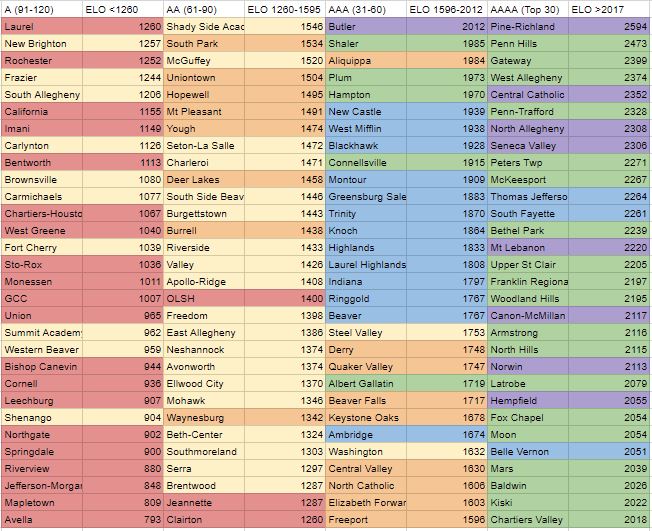
Breaking down the WPIAL by ELO classifications would allow teams to compete more directly against teams of their “quality” level. While there may be some initial push-back against teams competing with schools massively larger or smaller than them, let’s not forget about a few actual results. Aliquippa (which is the size of a 1A school) defeated New Castle (a 4A-sized school) in Week 0 games in 2016 and 2017 by scores of 44-28 and 24-0. Washington (a 2A school) crushed Laurel Highlands (a 4A school) 59-25 in Week 0 this year. It is absolutely feasible to think that the top smaller school teams (like Aliquippa, Steel Valley, and Washington) could be competitive against some schools that are larger than them. Even in the top classification, 4A Champions South Fayette lost a Week 0 game to Upper St Clair by 1 point this season. USC then defeated Mt. Lebanon (who made the 6A semifinals) 28-7 later in the season. Once again, it is absolutely feasible that the top 4A-sized schools could be competitive against 5A and 6A-sized schools.
Just for the fun of it, here’s a potential alignment of conferences based on using ELO to determine classifications:
Aligning teams into classifications based on ELO rankings would also enable teams to move up or down in classification based on recent success. Teams that suffered long losing streaks would not be stuck in a higher classification but rather would be able to move down to take on opponents that may be closer to their quality level. On the flip side, teams that have traditionally dominated will continue to move up the scale and face increasingly difficult competition. Obviously, since this is a ranking of high school teams which experience complete roster turnover every 4 years, reassigning teams to classifications every 2 years would still make sense (though it could be done every year as the ELO rankings change). If teams were assigned to classifications based on quality, it may also be worth considering 5 classifications (of 24 teams each) rather than 4 classifications (of 30 teams) to better delineate the “tiers.” Here is how the ELO rankings would look broken into 5 classes:
Merge With Other Districts
WPIAL and the Pittsburgh City League
Another potential option for future consideration would be to merge with another district. Statewide, the PIAA is divided into 12 districts. The WPIAL (District 7) has the most football-playing schools at 120 of the 567 schools statewide. The smallest district is the Pittsburgh City League (District 8) with only 6 football-playing schools. That number dropped to 5 this year when Carrick folded their team in the middle of the season because they did not have enough players. A potential merger between the WPIAL and City League for football only would be logistically easy as the City League teams are already located within the WPIAL geographic footprint. If the WPIAL and City League merged, the WPIAL would add 1 6A school (Taylor Allderdice), 1 5A school (Brashear), possibly 2 4A schools (University Prep and Carrick, if they continued to field a team), 2 3A schools (Perry and Westinghouse).
Under the 4-classification model where statewide enrollments determine classification, the City League schools would be split thusly:
AAAA would add both Allderdice and Brashear, bringing it to 23 teams.
AAA would add Carrick and University Prep, bringing it to 29 teams.
AA would add Perry and Westinghouse, bringing it to 33 teams.
A would not add any teams and remain at 40 teams.
Under the 4-classification model where the WPIAL was evenly distributed across classifications, two classes would now have to have 32 teams while two others had 31.
- Allderdice and Brashear would join AAAA for a total of 32 teams in AAAA.
- Carrick, University Prep, Westinghouse, and Perry would all join AAA. To make scheduling easier and only have to have 1 game per week between classifications, it would make the most sense for AAA and AA to have 31 teams while Quad-A and Single-A had 32.
- To keep AAA at 31 teams, South Park, Hopewell, and Waynesburg would move down to AA.
- While those 3 teams would join AA, in order for AA to have 31 teams two teams would have to move down to Class A, which would be Apollo-Ridge and Brentwood, based on enrollment figures.
My ELO rankings do not include City League schools, but given their enrollment sizes (and where they would have started on the scale) it is likely that the six City League schools would land somewhere in AA, AAA or AAAA based on the ELO ratings mentioned above.
Western Pennsylvania Football League
I will fully admit that this final scenario is a bit of a pipe dream of mine and will likely never come to fruition. But since we are talking about ways to fix the WPIAL, I might as well throw out one radically different option. In this case, the WPIAL and Pittsburgh City League would join with District 10 (Northwestern PA) to from a “Western Pennsylvania Football League.” This consolidation would span 15 counties, bringing in Erie, Warren, Crawford, Mercer, Venango, and part of Forest counties from District 10. There has been a lot of consternation over the last three years about how six classifications is not working for the District 10 teams. With 38 schools in D10, only two classifications even have enough teams to field a full schedule against teams in their class. If people in the WPIAL region thought having just 9 teams in 6A was bad this season, consider that D10 has just two 6A schools and only two schools playing in 4A. District 10 has also had 5 schools (Warren, Meadville, Franklin, Oil City, and General McLane) opt to play up in 5A in order to not have to face Cathedral Prep in 4A.
So what would a “Western PA Football League” look like? Adding in the 6 City League schools and 38 D10 schools would total 164 football-playing schools. This would be about 30% of the football-playing schools in the entire state. To go back to 4 classifications, as Erie Times-News sportswriter Tom Reisenweber has continually championed for D10, the classes would have the following breakdown:
Four Classifications Based on State-wide Enrollment:
- 25 teams in AAAA (21 WPIAL teams, Allderdice and Brashear from D8, Erie and McDowell from D10).
- This number could go up to 30 if the 5 teams from D10 that currently play up in 5A to avoid Cathedral Prep would once again opt to play up.
- 36 teams in AAA (27 WPIAL teams, Carrick and University Prep from D8, From D10: Cathedral Prep, Meadville, General McLane, Fort LeBoeuf, Warren, Franklin, and Oil City)
- 48 teams in AA (31 from the WPIAL, Perry and Westinghouse from D8, 15 schools from D10)
- 54 teams in Class A (40 from the WPIAL, none from D8, 14 schools from D10)
Four Classifications Based on Evenly-Distributed Classes:
Having Four Classifications with even numbers in each would mean 41 teams in each classification.
- AAAA would add (in addition to the 30 WPIAL teams shown above) Allderdice and Brashear from the City League and Erie and McDowell from D10. In order to get to 41 teams, the enrollment cutoff would drop from 391 (as it was in the WPIAL-only model) to 370. This would add Mars, McKeesport, Albert Gallatin, Trinity, from the WPIAL; Carrick from the City League; and Cathedral Prep and Meadville from D10.
- AAA would have an enrollment cutoff of 225, the same cutoff as the evenly-distributed WPIAL. The four WPIAL schools that moved up to Quad-A in this model would be replaced by 3 City League schools (Westinghouse, University Prep, and Perry). D10 would add 12 schools to the fold – General McLane, Fort LeBoeuf, Warren, Franklin, Slippery Rock, Harbor Creek, Oil City, Conneaut, Corry, Grove City, Hickory, and Titusville.
- AA would have the same 30 WPIAL teams as listed above and add 11 schools from D10. These additions would be: North East, Sharon, Fairview, Girard, Seneca, Mercyhurst Prep, Greenville, Northwestern, Sharpsville, Iroquois, and Wilmington.
- Sharon, Sharpsville, and Wilmington could easily be placed in a conference with nearby WPIAL teams like Neshannock, Mohawk, Riverside, and Ellwood City.
- Class A would also remain as schools with an enrollment smaller than 145. In addition to the 30 WPIAL schools listed above, 11 D10 schools would be added: Reynolds, Union City, Cambridge Springs, Lakeview, Mercer, Eisenhower, Maplewood, Saegertown, Cochranton, West Middlesex, and Farrell.
- Mercer, West Middlesex, and Farrell could easily be placed in a conference with WPIAL teams such as Shenango, Union, and Laurel (amongst others).
It is interesting to note that from the “Evenly Distributed WPIAL Classes” listed above, the cutoff lines would only change for one classification (AAAA) if the WPIAL was merged with District 10 and District 8 (City League). That said, having 41 teams per classification may make it a bit unweildy, it certainly would make qualifying for a 16-team playoff quite prestigious. If this ever came to fruition, it may be worth considering five classifications evenly distributed with 32 or 33 teams each (perhaps even using a metric like ELO rankings to rank teams based on quality so that you don’t have schools playing up to try to avoid facing a team like Cathedral Prep.) As I said at the outset of this section, a “Western Pennsylvania Football League” may be a bit of a pipe dream and probably would be unlikely to occur, but the sentiment certainly exists in District 10 to move back to four classifications, and if the WPIAL led the way that could open the door for other districts to consider it in the future.
Conclusion
In conclusion, Year 3 of the six-classification alignment has shown some more cracks in the armor, but the districts in the eastern part of the state that pushed for the change are still largely dominated by the same schools. The statewide debate has shifted to a “public school vs non-boundary school” discussion rather than focusing on the fact that six classifications has created increased travel and lowered the competitiveness of games across the board. WPIAL Executive Director Tim O’Malley has noted that an increasing number of schools within the WPIAL seem to favor a move back to four classes, and if a majority are in favor it is something the WPIAL will consider in the next alignment cycle (2020-2021). However, it is unclear whether the WPIAL would use state-wide enrollment figures, evenly-distributed classes, or some other metric (like an ELO ranking) to distribute teams into classifications. The WPIAL certainly has a preference for four championship games in order to continue to hold those games at Heinz Field, and having four classes is the best way to achieve that. It will be interesting to see if additional school districts bring up the question of leaving the WPIAL for football only as travel budgets continue to increase and their teams continue to be uncompetitive. Albert Gallatin has already thrown down the gauntlet and Uniontown brought up the question (but voted it down). More schools threatening to leave could force the WPIAL’s hand to return to four classes or re-examine their current structures of conference alignments and scheduling (which is an issue for another post).



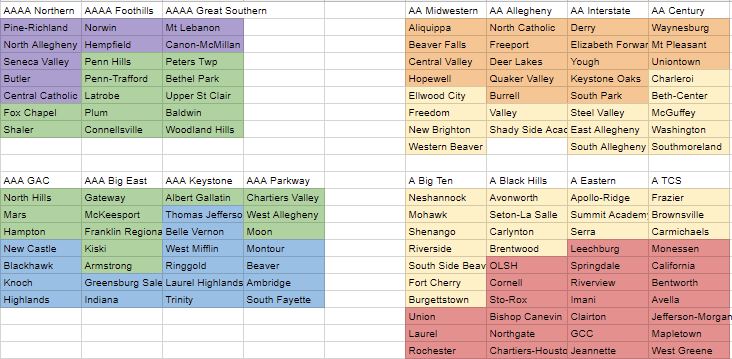
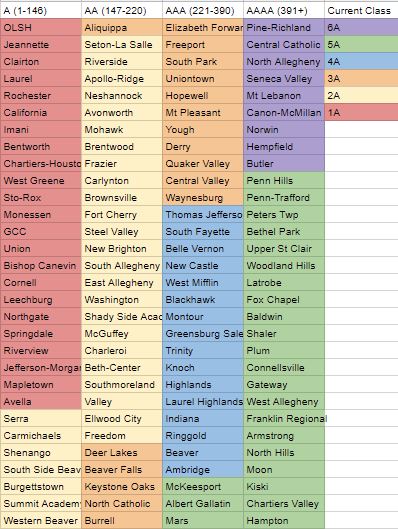
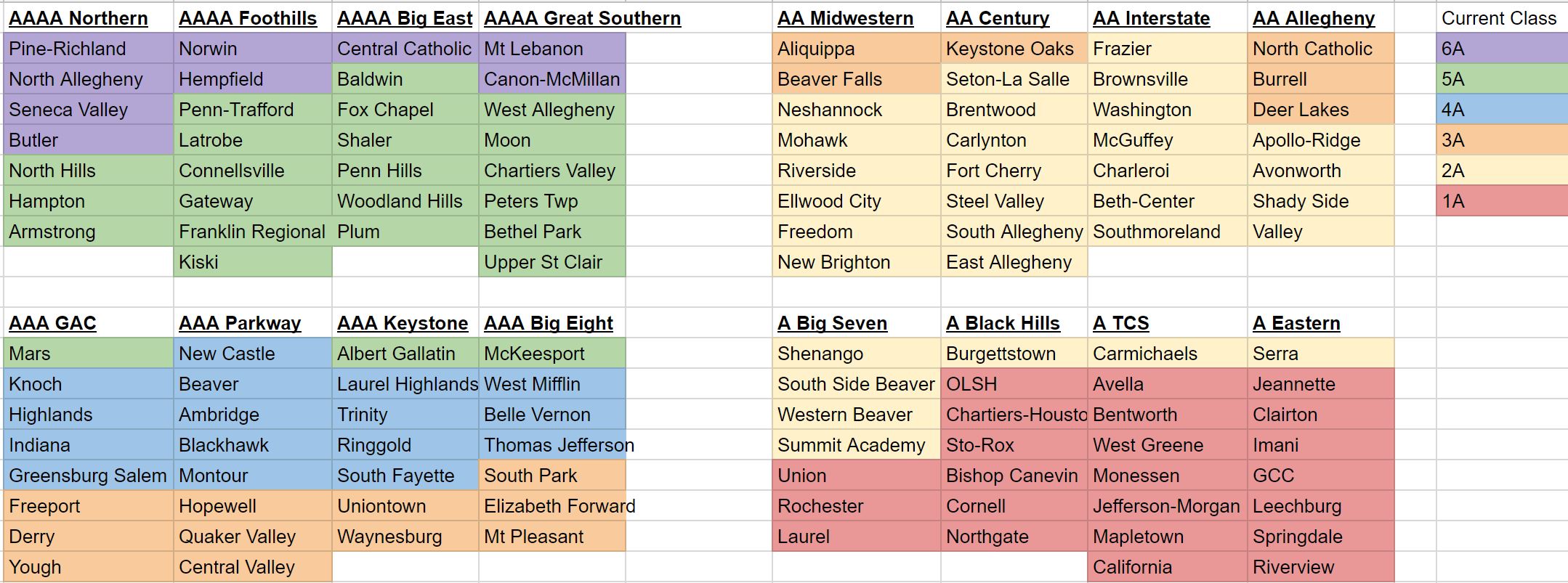
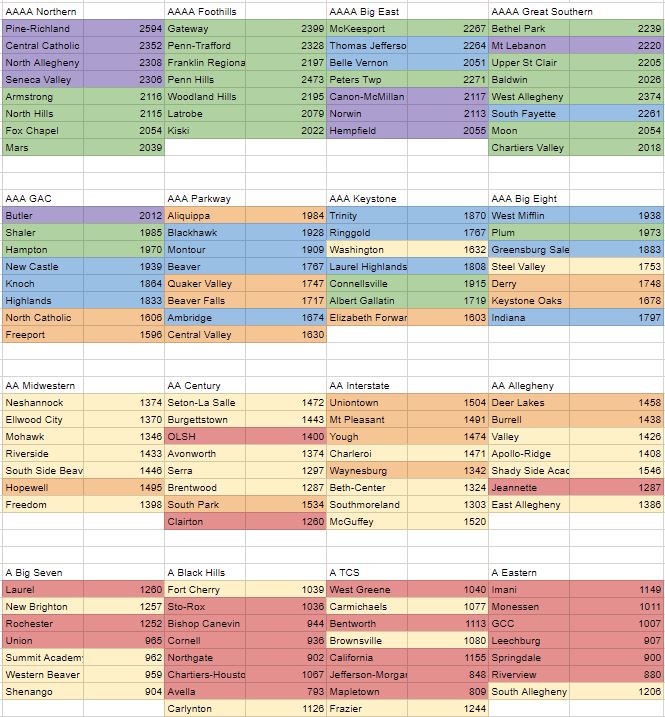

1 comment
[…] classifications, inter-classification games were necessary throughout the schedule. Last year, I wrote an article about potential strategies to fix the alignment problems the move to six classifications has […]